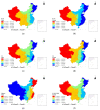Multiscale Impact of Environmental and Socio-Economic Factors on Low Physical Fitness among Chinese Adolescents and Regionalized Coping Strategies
- PMID: 36294085
- PMCID: PMC9602530
- DOI: 10.3390/ijerph192013504
Multiscale Impact of Environmental and Socio-Economic Factors on Low Physical Fitness among Chinese Adolescents and Regionalized Coping Strategies
Abstract
As low physical fitness in adolescents increases their risk of all-cause mortality in future adulthood as well as regional public health budgets, many scholars have studied the factors influencing physical fitness in adolescents. However, the spatial non-stationarity and scale between physical fitness and influencing factors in adolescents are often neglected. To rectify this situation, this study constructed a multi-scale geographically weighted regression model based on data from the China National Student Fitness Survey and the China Statistical Yearbook in 2018 to investigate the spatial patterns of factors influencing low physical fitness among adolescents. The results showed that the influencing factors for measuring the physical fitness of Chinese adolescents had significant spatial heterogeneity and multi-scale effects. The local R2 values were relatively low in the western region of China. Consideration should be given to increasing the lifestyle and ethnic and cultural characteristics of local residents when selecting influencing factors in the future. The physical fitness of men was mainly influenced by socio-economic factors, while that of women was influenced by natural environmental factors. According to the different spatial distribution patterns of MGWR, this study suggests that each region should develop regionalized strategies to cope with the low physical fitness of adolescents, including taking advantage of the natural environment to develop physical fitness promotion projects, accelerating the upgrading of industrial structures in the north-eastern and western regions, and the need to remain cautious of rapid urbanization in the east.
Keywords: China; coping strategies; environmental factors; multi-scale geographic weighted regression (MGWR); physical fitness; public health; socio-economic factors; spatial heterogeneity.
Conflict of interest statement
The authors declare no conflict of interest.
Figures



Similar articles
-
Spatial Heterogeneity and Regional Clustering of Factors Influencing Chinese Adolescents' Physical Fitness.Int J Environ Res Public Health. 2023 Feb 21;20(5):3836. doi: 10.3390/ijerph20053836. Int J Environ Res Public Health. 2023. PMID: 36900845 Free PMC article.
-
How do varying socio-economic factors affect the scale of land transfer? Evidence from 287 cities in China.Environ Sci Pollut Res Int. 2022 Jun;29(27):40865-40877. doi: 10.1007/s11356-021-18126-6. Epub 2022 Jan 27. Environ Sci Pollut Res Int. 2022. PMID: 35083677
-
How do varying socio-economic driving forces affect China's carbon emissions? New evidence from a multiscale geographically weighted regression model.Environ Sci Pollut Res Int. 2021 Aug;28(30):41242-41254. doi: 10.1007/s11356-021-13444-1. Epub 2021 Mar 29. Environ Sci Pollut Res Int. 2021. PMID: 33779906
-
Spatial non-equilibrium and distribution dynamic evolution of the development level of national physical fitness in China's provinces.PLoS One. 2024 Aug 7;19(8):e0287806. doi: 10.1371/journal.pone.0287806. eCollection 2024. PLoS One. 2024. PMID: 39110755 Free PMC article.
-
Analysis of China's Industrial Green Development Efficiency and Driving Factors: Research Based on MGWR.Int J Environ Res Public Health. 2021 Apr 9;18(8):3960. doi: 10.3390/ijerph18083960. Int J Environ Res Public Health. 2021. PMID: 33918717 Free PMC article.
Cited by
-
Spatial-temporal evolution of overweight and obesity among Chinese adolescents from 2016 to 2020.iScience. 2023 Dec 14;27(1):108742. doi: 10.1016/j.isci.2023.108742. eCollection 2024 Jan 19. iScience. 2023. PMID: 38230263 Free PMC article.
-
Inequality and heterogeneity in medical resources for children with autism spectrum disorders: a study in the ethnic minority region of southern China.BMC Public Health. 2025 May 7;25(1):1677. doi: 10.1186/s12889-025-22871-5. BMC Public Health. 2025. PMID: 40336016 Free PMC article.
-
Spatial Heterogeneity and Regional Clustering of Factors Influencing Chinese Adolescents' Physical Fitness.Int J Environ Res Public Health. 2023 Feb 21;20(5):3836. doi: 10.3390/ijerph20053836. Int J Environ Res Public Health. 2023. PMID: 36900845 Free PMC article.
-
A study on the spatiotemporal evolutionary pattern and influencing factors of sports venues in Xi'an.Sci Rep. 2025 Apr 19;15(1):13560. doi: 10.1038/s41598-025-98785-4. Sci Rep. 2025. PMID: 40253494 Free PMC article.
-
Global burden of ischemic stroke attributable to high body mass index in 204 countries and territories, 1990-2021.BMC Cardiovasc Disord. 2024 Oct 22;24(1):584. doi: 10.1186/s12872-024-04259-2. BMC Cardiovasc Disord. 2024. PMID: 39438799 Free PMC article.
References
-
- Högström G., Ohlsson H., Crump C., Sundquist J., Sundquist K. Aerobic fitness in late adolescence and the risk of cancer and cancer-associated mortality in adulthood: A prospective nationwide study of 1.2 million Swedish men. Cancer Epidemiol. 2019;59:58–63. doi: 10.1016/j.canep.2019.01.012. - DOI - PubMed
-
- Soysal P., Hurst C., Demurtas J., Firth J., Howden R., Yang L., Tully M.A., Koyanagi A., Ilie P.C., López-Sánchez G.F. Handgrip strength and health outcomes: Umbrella review of systematic reviews with meta-analyses of observational studies. J. Sport Health Sci. 2021;10:290–295. doi: 10.1016/j.jshs.2020.06.009. - DOI - PMC - PubMed
Publication types
MeSH terms
Grants and funding
LinkOut - more resources
Full Text Sources
Medical
Research Materials

